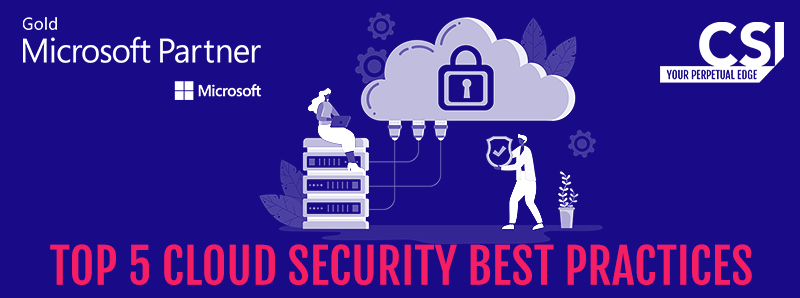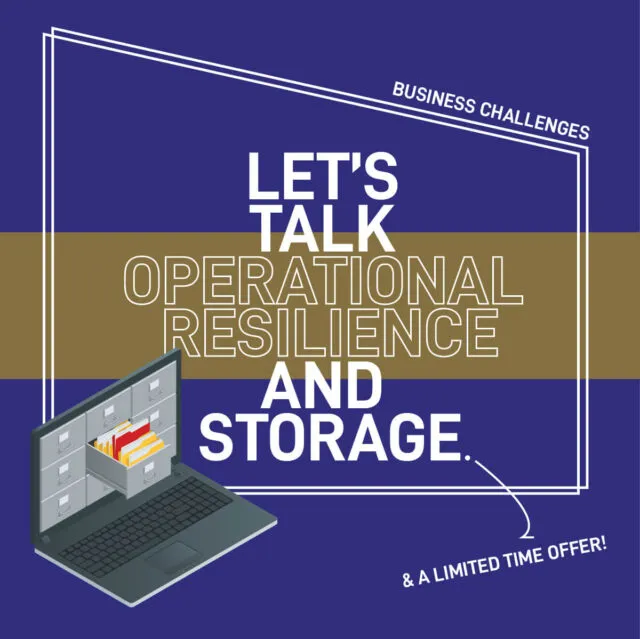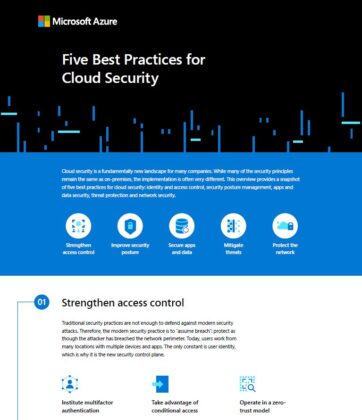Top 5 Cloud Security Best Practices

While many of the security principles in the cloud remain the same as on-premises, the implementation is often very different. In this Microsoft Azure infographic, we look at the five best practices for cloud security:
- identity and access control
- security posture management
- apps and data security
- threat protection
- network security
Click here to view the infographic PDF
1. Strengthen Access Control
Traditional security practices are not enough to defend against modern security attacks. Therefore, the modern security practice is to “assume breach”: protect as though the attacker has breached the network perimeter. Today, users work from many locations with multiple devices and apps. The only constant is user identity, which is why it is the new security control plane.
Institute multifactor authentication
Provide another layer of security by requiring two or more of the following authentication methods:
- Something you know (typically a password)
- Something you have (a trusted device that is not easily duplicated, like a phone)
- Something you are (biometrics)
Take advantage of conditional access
Master the balance between security and productivity by factoring how a resource is accessed into an access control decision. Implement automated access control decisions for accessing your cloud apps that are based on conditions.
Operate in a zero-trust model
Verify the identity of everything and anything trying to authenticate or connect before granting access.
2. Improve Security Posture
With more and more recommendations and security vulnerabilities identified, it is harder to triage and prioritise response. Make sure that you have the tools you need to assess your current environments and assets and identify potential security issues.
Improve your current posture
Use a tool like Secure Score in Azure Security Centre to understand and improve your security posture by implementing best practices.
Educate Stakeholders
Share progress on your secure score with stakeholders to demonstrate the value that you are providing to the business as you improve organisational security.
Collaborate with your DevOps team on policies
To get out of reactive mode, you must work with your DevOps teams in advance to apply key security policies at the beginning of the engineering cycle as secure DevOps.
3. Secure Apps and Data
Protect data, apps, and infrastructure through a layered, defence-in-depth strategy across identity, data, hosts, and networks.
Encryption
Encrypt data at rest and in transit. Consider encrypting data at use with confidential computing technologies.
Follow security best practices
Ensure your open-source dependencies do not have vulnerabilities. Additionally, train your developers in security best practices such as Security Development Lifecycle (SDL).
Share the responsibility
When a company operates primarily on premises, it owns the whole stack and is responsible for its own security. Depending on how you use the cloud, your responsibilities change, with some responsibilities moving to your cloud provider.
- IaaS: for applications running in virtual machines, more of the burden is on the customer to ensure that both the application and OS are secure.
- PaaS: as you move to cloud-native PaaS, cloud providers like Microsoft will take more of the security responsibility at the OS level itself.
- SaaS: at the SaaS level, more responsibility shifts away from the customer. See the shared responsibility model.
4. Mitigate Threats
Operational security posture – protect, detect and respond – should be informed by unparalleled security intelligence to identify rapidly evolving threats early so you can respond quickly.
Enable detection for all resource types
Ensure threat detection is enabled for virtual machines, databases, storage, and IoT. Azure Security Centre has built-in threat detection that supports all Azure resource types.
Integrate threat intelligence
Use a cloud provider that integrates threat intelligence, providing the necessary context, relevance, and prioritisation for you to make faster, better, and more proactive decisions.
Modernise your security information and event management (SIEM)
Consider a cloud-native SIEM that scales with your needs, uses AI to reduce noise, and requires no infrastructure.
5. Protect the Network
We’re in a time of transformation for network security. As the landscape changes, your security solutions must meet the challenges of the evolving threat landscape and make it more difficult for attackers to exploit networks.
Keep strong firewall protection
Setting up your firewall is still important, even with identity and access management. Controls need to be in place to protect the perimeter, detect hostile activity and build your response. A web application firewall (WAF) protects web apps from common exploits like SQL injection and cross-site scripting.
Enable Distributed Denial of Service (DDoS) Protection
Protect web assets and networks from malicious traffic targeting application and network layers, to maintain availability and performance, while containing operating costs.
Create a micro-segmented network
A flat network makes it easier for attackers to move laterally. Familiarise yourself with concepts like virtual networking, subnet provisioning and IP addressing. Use micro-segmentation, and embrace a whole new concept of micro perimeters to support zero trust networking.
What Next?
To strengthen your cloud security, and for help to protect data and workloads in the cloud or on-premises, contact CSI today.
Read more like this

IBM Power
Why Private infrastructure is better for AI
Running AI Models vs. Building New AI Models: Inferencing and Training To make informed platform choices depends on a clear…

Storage and Backup
Improving Operational Resilience (With AI-driven Technology)
The Financial Impact of Cyber Attacks is Underestimated On average, analysts have discovered, a cyber-attack will force a UK SME…

Compliance
DORA or not to DORA – What Next for UK Banks?
DORA Recap: What, Where & Why Firstly, it’s critical to know that DORA is a benchmark piece of regulation that…
Ready to talk?
Get in touch today to discuss your IT challenges and goals. No matter what’s happening in your IT environment right now, discover how our experts can help your business discover its competitive edge.
